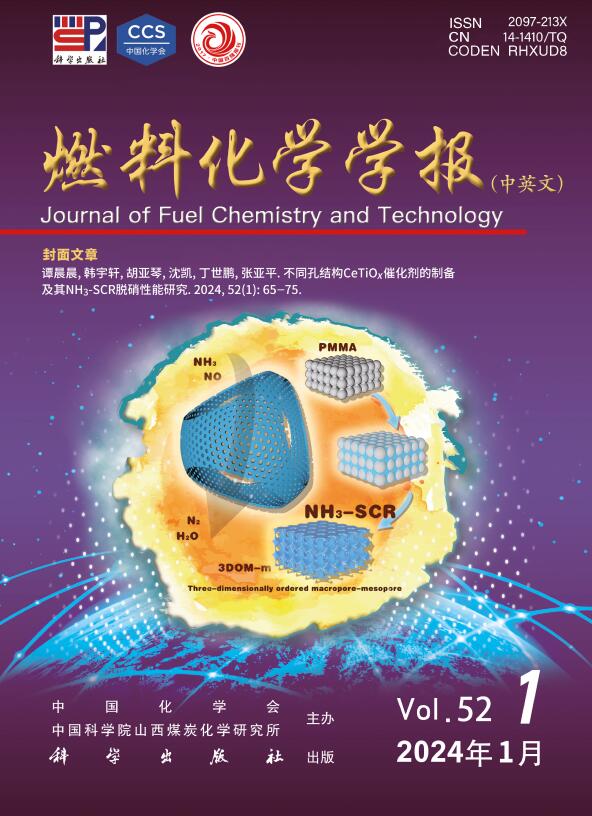Study on performance of Fe2N catalyst modified by hydrophobic PDVB-DMF for Fischer-Tropsch synthesis
Q3 Energy
引用次数: 0
Abstract
Fe-based catalysts are commonly used in Fischer-Tropsch synthesis. However, high water pressure in the process can easily lead to oxidation and deactivation of the active phase of the catalyst. Therefore, timely removal of the generated water from the catalyst surface is a key measure to prevent oxidation of the active phase and prolong the lifetime of the catalyst. In this work, hydrophobic agent-porous polydivinylbenzene was mixed with Fe2N catalyst. The hydrophobicity of porous polydivinylbenzene accelerated the water migration in local microenvironment. This strategy effectively balanced the adsorption and release of water on the catalyst surface, reduced the occupation of water on the active site and promoted the efficient conversion of syngas. The CO conversion of Fe2N without porous hydrophobic agent was only 34.8%. The active phase was oxidized during the reaction. While CO conversion of Fe2N mixed with porous hydrophobic agent was as high as 80.2%, and no oxidation of active phase was observed after reaction. This work shows that hydrophobic polymers have excellent effects in optimizing catalyst microenvironment, improving reaction efficiency and product selectivity, and thus provides a new strategy for syngas conversion.
疏水PDVB-DMF修饰Fe2N费托合成催化剂性能研究
铁基催化剂是常用的费托合成催化剂。但在此过程中,较高的水压容易导致催化剂的活性相氧化和失活。因此,及时清除催化剂表面生成的水是防止活性相氧化、延长催化剂寿命的关键措施。本研究将疏水剂多孔聚二乙烯苯与Fe2N催化剂混合。多孔聚二乙烯苯的疏水性加速了水在局部微环境中的迁移。该策略有效平衡了水在催化剂表面的吸附和释放,减少了水在活性部位的占用,促进了合成气的高效转化。无多孔疏水剂Fe2N的CO转化率仅为34.8%。反应过程中,活性相被氧化。而Fe2N与多孔疏水剂混合后CO转化率高达80.2%,反应后活性相未发生氧化。本研究表明疏水聚合物在优化催化剂微环境、提高反应效率和产物选择性方面具有优异的效果,为合成气转化提供了新的策略。
本文章由计算机程序翻译,如有差异,请以英文原文为准。
求助全文
约1分钟内获得全文
求助全文
来源期刊

燃料化学学报
Chemical Engineering-Chemical Engineering (all)
CiteScore
2.80
自引率
0.00%
发文量
5825
期刊介绍:
Journal of Fuel Chemistry and Technology (Ranliao Huaxue Xuebao) is a Chinese Academy of Sciences(CAS) journal started in 1956, sponsored by the Chinese Chemical Society and the Institute of Coal Chemistry, Chinese Academy of Sciences(CAS). The journal is published bimonthly by Science Press in China and widely distributed in about 20 countries. Journal of Fuel Chemistry and Technology publishes reports of both basic and applied research in the chemistry and chemical engineering of many energy sources, including that involved in the nature, processing and utilization of coal, petroleum, oil shale, natural gas, biomass and synfuels, as well as related subjects of increasing interest such as C1 chemistry, pollutions control and new catalytic materials. Types of publications include original research articles, short communications, research notes and reviews. Both domestic and international contributors are welcome. Manuscripts written in Chinese or English will be accepted. Additional English titles, abstracts and key words should be included in Chinese manuscripts. All manuscripts are subject to critical review by the editorial committee, which is composed of about 10 foreign and 50 Chinese experts in fuel science. Journal of Fuel Chemistry and Technology has been a source of primary research work in fuel chemistry as a Chinese core scientific periodical.
 求助内容:
求助内容: 应助结果提醒方式:
应助结果提醒方式:


